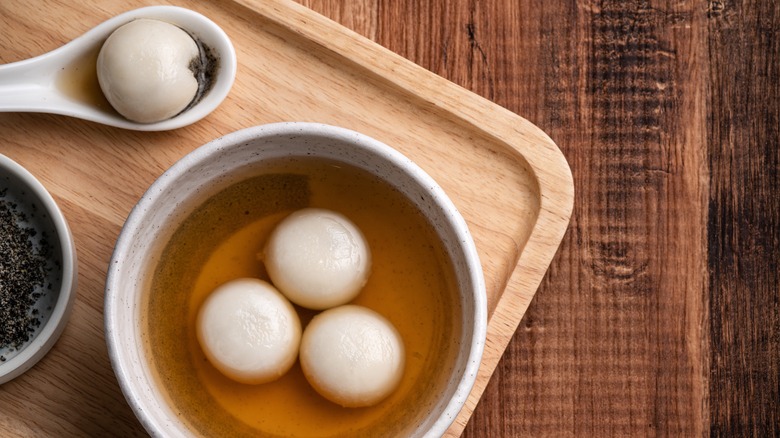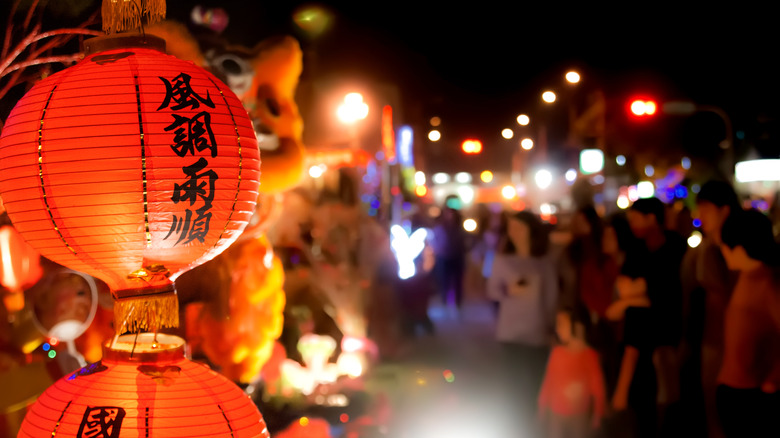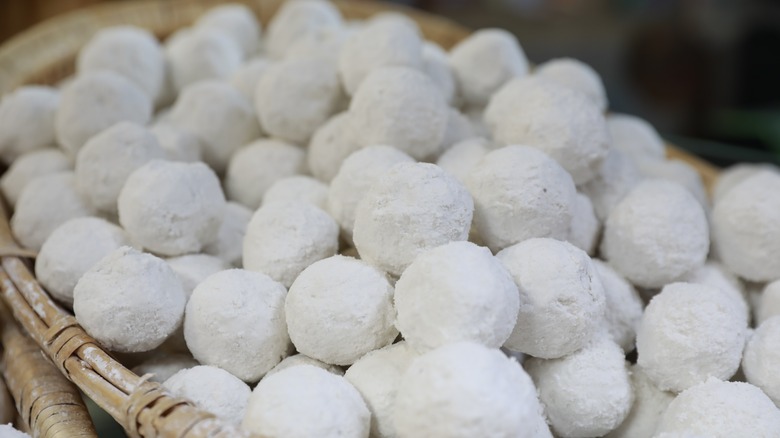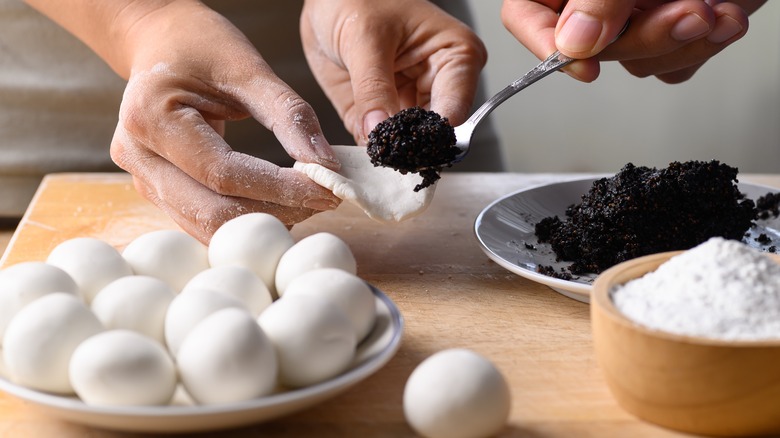Tang Yuan: The Chinese Rice Balls That Can House A Variety Of Fillings
Tang yuan, glutinous rice balls, has been a popular dessert in China for centuries (via the BBC). Soft and chewy, these dumplings are served in a sweet soup and traditionally eaten during the Yuan Xiao festival, known in English as Lantern Festival. The sweet dumplings originated in the city of Ningbo 1,100 years ago and spread throughout China to become a staple of Chinese cuisine. Tang yuan varies in size, taste, and preparation and consists of a glutinous rice flour dough wrapped around a sesame or red bean paste filling and can be served in a broth.
While some families make the rice balls at home, CGTN reports that others buy them from shops. In Beijing, people wait for hours on the morning of the Lantern Festival to buy tang yuan from popular vendors. As delicious as tang yuan are, the glutinous rice flour makes them hard to digest — so if you decide to try them, use moderation. And if you're superstitious, you should be doubly cautious: The BBC notes that a popular superstition encourages eating a red tang yuan and a white tang yuan together if you want to see another year.
Tang yuan has a strong connection to the Lantern Festival
While tang yuan is eaten year-round, they are typically associated Lantern Festival. According to Religious Celebrations: An Encyclopedia of Holidays, Festivals, Solemn Observances, and Spiritual Commemorations, the festival occurs 15 days after the Lunar New Year and marks the end of New Year's festivities. Since it always falls on the first full moon of the year, the holiday celebrates the triumph of light over darkness. As BBC explains, the round shape of tang yuan represents both the full moon and reunion.
In reference to the Chinese name for Lantern Festival, tang yuan was traditionally called yuan xiao throughout China. That changed in the early 20th century, when, according to legend, Chinese president Yuan Shikai insisted on changing the name to "tang yuan," which translates to "round balls in soup." His reasoning? "Yuan xiao" sounded too similar to the Chinese words for "remove Yuan," which he considered a threat. While the name stuck in Southern China, those in Northern and central China still use the term yuan xiao.
While they share their similarities, there have their differences — and it's not just their names. The taste and cooking processes vary (via China Educational Tutors).
Tang Yuan vs. Yuan Xiao
While tang yuan and yuan xiao are both made of glutenous rice flour and eaten during Lantern Festival, the two deserts are made distinctly. CGTN writes that tang yuan is crafted by hand and can include sweet or savory fillings. The outer layer of dough is formed by kneading it into a ball and wrapping it around the filling, much like making dumplings. Tang yuan typically has a softer texture and is sometimes dyed bright colors or molded into animal shapes.
Northern yuan xiao traditionally has a sweet taste and chewier texture. The fillings are dipped in water to achieve this texture and then rolled in a basket with glutinous rice flour. Gradually, the balls form as layers of rice flour stick to the filling — a tricky, time-consuming process compared to the straightforward approach of shaping tang yuan.
China Educational Tours notes that tang yuan freeze well, so they're often sold in supermarkets. Yuan xiao can only be eaten fresh since they crack if refrigerated.
What are the ingredients?
Tang yuan uses glutinous rice flour and regular rice flour. MasterClass explains that, while both ingredients are staples of Asian cuisine — especially deserts — they serve different purposes. Contrary to its name, glutinous rice flour contains zero gluten: Its name comes from its uniquely sticky, stretchy texture. Glutinous rice flour is made from sticky rice, which gives sweets like homemade mochi, boba pearls, and tang yuan their plump and filling chew.
Serious Eats explains that the tang yuan is filled with sugar, lard, and add-ins like ground sesame or nuts like peanuts, almonds, or cashews. For a slightly savory flavor, consider swapping out the lard for bacon fat. Like the fillings, the soup base varies too. Food52 explains that tang yuan is typically served in a sweet soup or broth with ginger syrup. Furthermore, tang yuan is part of a Chinese tradition of "dessert soups," called tong sui or "sugar water" in Cantonese.



